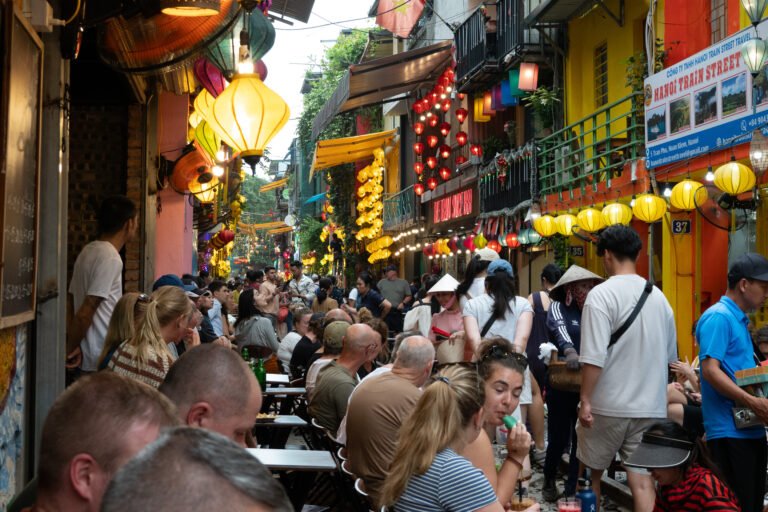How Much Should You Plan? Smart Travel Strategies for Over-50s

If there’s one great gift that comes with life as we approach or enter retirement, it’s freedom. Freedom from tight schedules, school holidays, and the extra cost of travelling with kids in tow.
Whether you’re recently retired or simply embracing a more flexible lifestyle, travel takes on a whole new meaning at this stage of life. It’s not just about ticking destinations off a list anymore—it’s about meaningful experiences, comfort, and a pace that suits you.
But with that freedom comes a new challenge: will you travel full-time or have a home base, how much should you plan ahead, and how much should you leave open to chance?
Some people love a detailed itinerary, complete with hotel confirmations, museum tickets, and restaurant reservations. Others prefer to follow their instincts, booking a flight and seeing where the road leads. Most of us fall somewhere in between.
Finding the right balance is key, you now have different needs and preferences than you did in your younger days. Maybe a bit more comfort, fewer surprises, and the peace of mind that comes with knowing certain things are taken care of, without sacrificing the joy of discovery.
In this guide, we’ll explore smart travel strategies for over-50s that help you plan just enough, and maximise your travel opportunities. Giving you structure where it matters and flexibility where it counts.
Whether you’re heading out on a solo adventure, a couples’ getaway, or a long-awaited retirement trip, these tips will help you travel smarter, stress less, and enjoy the journey even more.

The Planning Dilemma
During my years as a Travel Agent in Australia I assisted hundreds of people to plan and book everything from weekends away to once in a lifetime epic trips, and I have met people at every position on the pre-planning spectrum.
I have been handed itinerary spreadsheets that have every day laid out in 30 minute chunks, including all transport, activities and hotels. And I have dealt with people who just want a flight and plan to find transfers and a place to stay once they arrive.
Now these are at opposite ends of the scale and realistically represent a tiny fraction of travellers. And now we are going to help you work out if you are more comfortable at one of these extremes, or somewhere in between.
So the question is more than just How much planning is the right amount? There is no “one-size-fits-all” answer. The question we need to answer is How much planning is the right amount FOR YOU?
10 Questions to Help You Decide How Much to Plan for Your Trip
- What’s my travel budget, and how much financial risk am I comfortable taking by leaving things unbooked?
- Have I enjoyed previous trips more when I planned ahead, or when I left room for surprise?
- Do I feel more relaxed knowing everything is booked in advance, or does too much structure make me feel boxed in?
- How confident do I feel navigating unfamiliar places on the fly, finding hotels, meals, or transportation as I go?
- Is this destination busy or seasonal and could I miss out if I don’t plan ahead?
- How physically demanding is the trip? Do I want to reduce stress by minimising logistics during travel?
- How much time do I want to spend during the trip figuring out the next step?
- Am I comfortable using technology like apps, maps, translation tools to help me make decisions on the go?
- Will I be travelling solo, with a partner, or in a group, and how do our planning styles align?
- What kind of experiences matter most to me? Iconic sights, cultural immersion, relaxation, etc.
The Options: Overplanning vs Underplanning vs Balanced
Let’s start with the two ends of the spectrum:
- Overplanners love control. They know where they’re staying each night, what time the museum opens, and where they’ll be eating dinner. The upside? Less stress during the trip. The downside? There’s little room for spontaneity, and when forced changes come up, it can be stressful.
- Underplanners crave freedom. They might book a flight and a hotel for the first night, then see what unfolds. This can lead to exciting adventures, but also missed opportunities, higher prices, or wasted time figuring out logistics.
Neither approach is wrong, but each comes with trade-offs. The key is finding your sweet spot. Look at the following table to get an overview of how these planning styles compare based on several key aspects:
| Aspect | Over-Planning | Under-Planning | Balanced Approach |
|---|---|---|---|
| Peace of Mind | High—everything is booked | Low—uncertainty may cause stress | Moderate—key elements booked, but with room for flexibility |
| Flexibility | Low—difficult to change course | High—go with the flow | Medium—planned outline with open time blocks for spontaneous choices |
| Time Spent Planning | High—detailed itineraries, research, bookings | Low—minimal upfront planning | Moderate—focus on essentials (flights, first nights, major activities) |
| Daily Stress While Traveling | Low—everything is mapped out (although forced changes to plan may cause stress) | High—decisions must be made daily | Low to moderate—big decisions are done, daily flow is relaxed |
| Cost Efficiency | Often better—early deals and budget control | Can be more expensive—last-minute rates | Smart mix—book essentials early, leave some spending open for deals or upgrades |
| Spontaneity | Limited—schedule is full | High—freedom to go anywhere | Built-in—unstructured time allows for unplanned discoveries |
| Risk of Missing Out | Low—you’ve secured top sights/activities | High—popular spots may be sold out | Balanced—pre-book key experiences, leave rest open for exploration |
| Cultural Immersion | May be limited—sticking to tourist paths | High—room to follow local tips and detours | Strong—plan major sites, but leave space for real local interaction |
| Comfort Level for Over-50s | High—less physical and mental effort needed on the trip | Depends—may be too uncertain or tiring | Ideal—comfort and ease with freedom to adjust if energy levels or interests change |
| Travel Style Fit | Best for detail-oriented or anxious travelers | Best for free-spirits and seasoned backpackers | Best for most mature travelers who want smart structure and room to explore |
Personality and Travel Preferences
The first step in finding your planning sweet spot is to know your own comfort zone. Ask yourself:
- Do I feel anxious without a plan, or stifled by too much structure?
- How comfortable am I making decisions on the fly in unfamiliar settings?
- Do I like to wake up knowing what the day holds, or do I enjoy going with the flow?
Many over-50s travelers appreciate structure, but also want to leave room for flexibility. Travelling at our age can effect different people in very different way, and avoiding travel fatigue is a major consideration.
Some of us have grown in confidence based on past experiences and realise that they can handle anything that may come their way. While others get more nervous as they age and worry that their mind and body may not be up for spur of the moment decision making and extra physical demands.
Your ideal approach should reflect your travel personality, not someone else’s.

How Destinations Need Different Planning
Not all destinations lend themselves to the same level of spontaneity. Consider the nature of your trip:
- High-demand destinations (like Japan during cherry blossom season or Europe in summer) often require advance planning for accommodations, attractions, and transport.
- Remote or logistically complex places may need extra coordination—especially where transportation is limited.
- Laid-back destinations (like beach towns or countryside retreats) often allow more room to explore without a strict plan.
Research your destination to understand what needs to be booked ahead and what can wait.
Your Trip Type Matters
How long you are planning to be away and why you are travelling also affects how much planning is ideal:
- Short trips benefit from more structure so you can maximize your time. If you only have a few days it is probably a waste of precious time by trying to find the things you want to do only after you arrive.
- Longer trips allow for greater flexibility, especially if you’re slow travelling or exploring multiple regions. You have the time to ask locals or other travellers for recommendations, or stumble across special places.
- Special-purpose trips (like anniversaries, cruises, or family reunions) may require detailed coordination.
For retirees and semi-retired travelers, longer, slower trips are common, offering the luxury of time and the option to plan less rigidly. But remember that this is only the right way to plan and travel if it suits your personal comfort level.
Build the Planning Framework
Regardless the level of planning that fits your needs and personality, there are a few things that even the most laid-back planner should be doing. And then there are a few other parts of your trip that I highly recommend adding to the basics:
- The essentials that should be planned:
- Flights and entry requirements
- First night’s accommodation
- Key activities that require advance booking
- Suggested “planning skeleton” approach:
- Fixed points + flexible time in between
- Anchor days (important experiences or locations)
Common Mistakes in Planning Too Much or Too Little
Too much, or too little, planning can badly effect your travel experience. And it will certainly take some trails and error for you to find the right balance for you and your travel companions.
By understanding some of the common problems at each end of the planner scale, you can get a headstart on reaching that balance.
- Overplanning pitfalls: burnout, tight schedules, missed spontaneity, pressure to “stick to the plan.”
- Underplanning pitfalls: last-minute stress, missed experiences, higher costs, difficulty finding lodging.
After surviving what seemed like a lifetime of working, and years of dealing with the extra constraints of family travel, we “seasoned” travellers often prefer a smoother, more comfortable experience, so finding the middle ground helps avoid these extremes.
Finding Your Balance
The beauty of travel later in life is that you’ve probably already have enough previous experience to know what works for you. You should be well on your way to being able to use that knowledge to:
- Create a “skeleton itinerary” with key details in place.
- Make sure to leave at least 20–30% of your trip open for impromptu fun.
- Plan important experiences, but allow time to rest, explore neighborhoods, or follow new leads.
Many mature travelers find that mornings are best for scheduled activities, while afternoons and evenings lend themselves to relaxation and discovery.
Plan Enough to Feel Free
Travel should be about joy, not pressure. The right amount of planning gives you freedom, not restriction. For over-50s travellers, the smartest strategy is to plan just enough to feel comfortable, safe, and informed, while leaving room for the magic that happens when you let life unfold.
After all, you probably know by now that the best memories often aren’t the ones we schedule, they’re the ones we stumble upon when we have the time and space to enjoy the ride.

Our Travel Planning Style
Pauline and I would consider ourselves very experienced travellers, with over 30 years of travelling together to over 30 countries. And to be honest, our planning strategy is still evolving.
But there is no doubt that we do a much better job at it than we did 20 years ago, or even 10. And that is why you shouldn’t be scared of changing your own planning style and trying something new. If you don’t try new things you will never be able to work out what works or doesn’t work for you.
We usually keep our planning fairly loose and free, particularly if we are heading off on a road trip. However, we also know that there are times and places that require a very different style to create a great trip.
For example, we knew that Peru was not going to work for us as a road trip, and we also also wanted to make sure we could realise our dream of spending our 25th anniversary at Machu Picchu. So a group tour was better.
We had a similar idea for our recent Vietnam trip where we didn’t want to be driving, and decided to use the services of a local tour operator. They were able to arrange the basics of the trip and a few special events, and we also made sure to include plenty of free time to explore on our own.
Only you can decide how you should plan your ideal trips, but you should never be afraid to ask for help. A travel agent that has visited the destination can be a great help, as can a local operator at the destination.
In the end, planning travel, and visiting places, is supposed to be something that brings you joy, educates you, and opens your eyes to new things. It should never be something that causes stress, or scares you.
If planning a trip makes you anxious then maybe you’re planning the wrong trip! Let us know what you love or hate about travel planning.






